Distinct Contributions of Climate Change and Anthropogenic Activities to Evapotranspiration and Gross Primary Production Variations over Mainland China
Abstract
1. Introduction
2. Data and Methodology
2.1. Study Area
2.2. Dataset
2.3. Methodology
2.3.1. Remote Sensing-Based Ecohydrological Model
- (1)
- Penman–Monteith–Leuning model
- (2)
- LUE model
2.3.2. Optimization and Evaluation of Model Parameters
2.3.3. Attribution Method
- (1)
- Each driving variable is normalized to avoid the influence of units and values.
- (2)
- The standard ridge regression coefficients of ET and GPP to each variable are obtained.
- (3)
- The standard ridge regression coefficient and trends of variables are combined to calculate the contributions of each driving factor:where i is the number of driving factors, denotes the contributions of the normalized driving factor to the normalized trend of ET or GPP, and Xis_trend denotes the trend of the normalized driving factor.
- (4)
- Based on the trends and contributions of each normalized and actual driving factor, the relative and actual contributions of each controlling factor on ET or GPP variations are calculated as follows:where i is the number of driving factors; and , respectively, represent the relative and actual contributions of Xi to the trend of ET or GPP; Ys_trend denotes the normalized ET or GPP trend; and Ytrend denotes the actual trend of ET or GPP.
3. Results
3.1. Evaluation of Simulated ET and GPP
3.2. Spatiotemporal Trends of ET and GPP
3.3. Trends of Climate Factors and Vegetation
3.3.1. Trends in Climate Factors
3.3.2. Trends in Vegetation
3.4. Identification of Factor Attributions for Variations in ET and GPP
3.4.1. Relative Contributions of Influencing Factors
3.4.2. Actual Contributions of Influencing Factors
4. Discussion
4.1. Spatial Pattern of Dominant Factors Controlling Variations in ET and GPP
4.2. Influences of Anthropogenic Activities on ET and GPP Trends
4.3. Policy Implications
4.4. Uncertainties
5. Conclusions
Author Contributions
Funding
Data Availability Statement
Acknowledgments
Conflicts of Interest
Appendix A
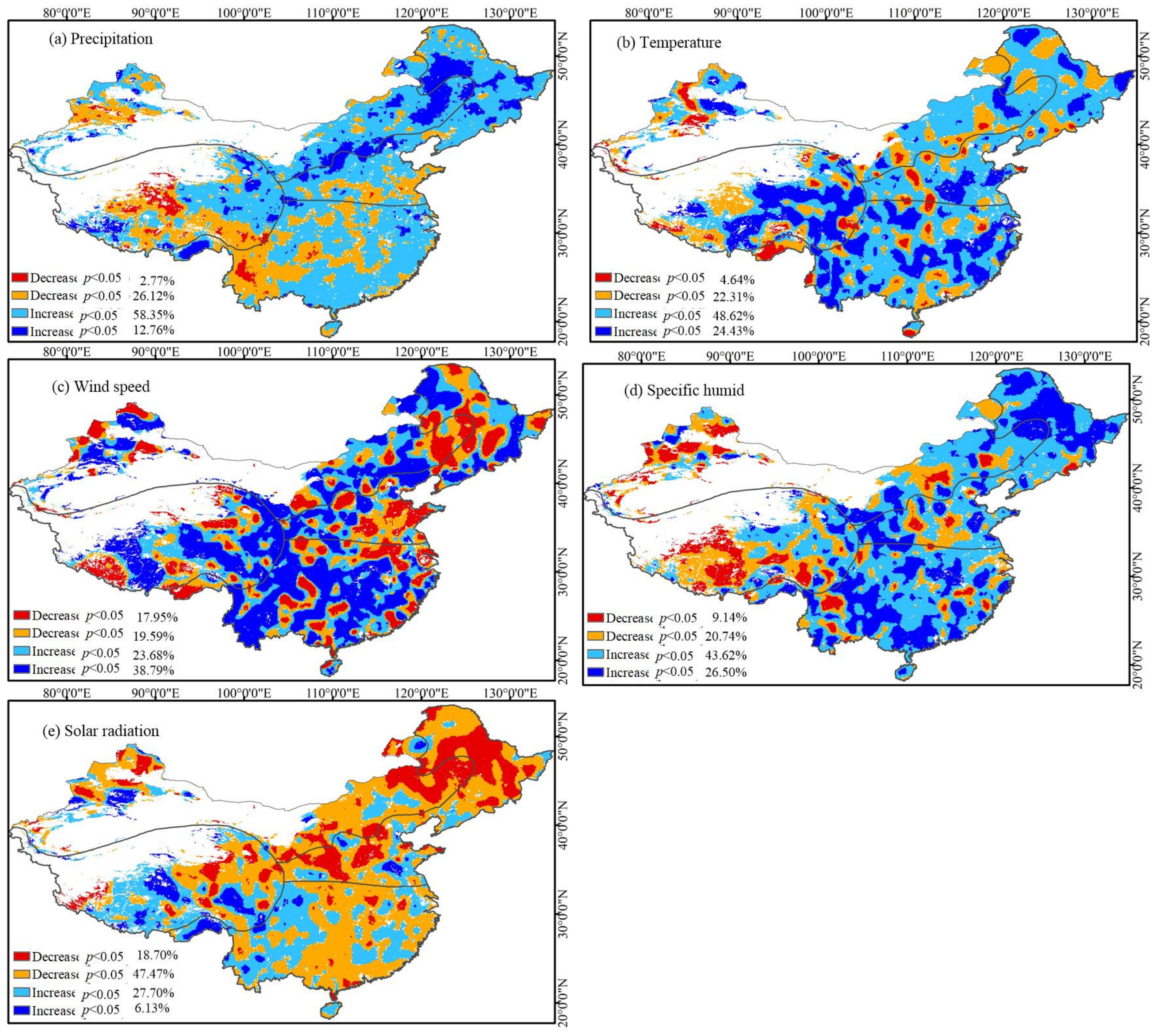
References
- Jiang, P.; Ding, W.G.; Yuan, Y.; Hu, L.Q.; Ye, W.F. Identifying trend shifts in vegetation greenness in China from 1982 to 2015. Land Degrad. Dev. 2022, 33, 1434–1445. [Google Scholar] [CrossRef]
- Niu, Z.; He, H.; Zhu, G.; Ren, X.; Zhang, L.; Zhang, K. An increasing trend in the ratio of transpiration to total terrestrial evapotranspiration in China from 1982 to 2015 caused by greening and warming. Agric. For. Meteorol. 2019, 279, 107701. [Google Scholar] [CrossRef]
- Piao, S.; Yin, G.; Tan, J.; Cheng, L.; Huang, M.; Li, Y.; Liu, R.; Mao, J.; Myneni, R.B.; Peng, S.; et al. Detection and attribution of vegetation greening trend in China over the last 30 years. Glob. Chang. Biol. 2015, 21, 1601–1609. [Google Scholar] [CrossRef]
- Wu, J.Z.; Zhang, J.; Ge, Z.M.; Xing, L.W.; Han, S.Q.; Shen, C.; Kong, F.T. Impact of climate change on maize yield in China from 1979 to 2016. J. Integr. Agr. 2021, 20, 289–299. [Google Scholar] [CrossRef]
- Li, Y.; Piao, S.; Li, L.Z.X.; Chen, A.; Wang, X.; Ciais, P.; Huang, L.; Lian, X.; Peng, S.; Zeng, Z.; et al. Divergent hydrological response to large-scale afforestation and vegetation greening in China. Sci. Adv. 2018, 4, 9. [Google Scholar] [CrossRef] [PubMed]
- Xue, Y.Y.; Liang, H.B.; Zhang, B.Q.; He, C.S. Vegetation restoration dominated the variation of water use efficiency in China. J. Hydrol. 2022, 612, 128257. [Google Scholar] [CrossRef]
- Baldocchi, D.; Meyers, T. On using eco-physiological, micro-meteorological and biogeochemical theory to evaluate carbon dioxide, water vapor and trace gas fluxes over vegetation: A perspective. Agr. Forest Meteorol. 1998, 90, 1–25. [Google Scholar] [CrossRef]
- Mo, X.G.; Liu, S.X.; Chen, X.J.; Hu, S. Variability, tendencies, and climate controls of terrestrial evapotranspiration and gross primary productivity in the recent decade over China. Ecohydrology 2018, 11, e1951. [Google Scholar] [CrossRef]
- Seneviratne, S.I.; Lüthi, D.; Litschi, M.; Schär, C. Land–atmosphere coupling and climate change in Europe. Nature 2006, 443, 205–209. [Google Scholar] [CrossRef]
- Xie, S.D.; Mo, X.G.; Hu, S.; Liu, S.X. Contributions of climate change, elevated atmospheric CO2 and human activities to ET and GPP trends in the Three-North Region of China. Agric. Forest Meteorol. 2020, 295, 108183. [Google Scholar] [CrossRef]
- Cavalcante, R.B.L.; Pontes, P.R.M.; Souza, P.W.M.; de Souza, E.B. Opposite effects of climate and land use changes on the annual water balance in the Amazon arc of deforestation. Water Resour. Res. 2019, 55, 3092–3106. [Google Scholar] [CrossRef]
- Katul, G.G.; Oren, R.; Manzoni, S.; Higgins, C.; Parlange, M.B. Evapotranspiration: A process driving mass transport and energy exchange in the soil-plant-atmosphereclimate system. Rev. Geophys. 2012, 50, RG3002. [Google Scholar] [CrossRef]
- Puma, M.J.; Koster, R.D.; Cook, B.I. Phenological versus meteorological controls on land-atmosphere water and carbon fluxes. J. Geophys. Res. Biogeosci. 2013, 118, 14–29. [Google Scholar] [CrossRef]
- Jiang, H.L.; Xu, X.; Guan, M.X.; Wang, L.F.; Huang, Y.M.; Jiang, Y. Determining the contributions of climate change and human activities to vegetation dynamics in agro-pastural transitional zone of northern China from 2000 to 2015. Sci. Total Environ. 2020, 718, 134871. [Google Scholar] [CrossRef]
- Radda, I.A.; Kumar, B.M.; Pathak, P. Land Degradation in Bihar, India: An Assessment Using Rain-Use Efficiency and Residual Trend Analysis. Agric. Res. 2021, 10, 434–447. [Google Scholar] [CrossRef]
- Bai, P.; Liu, X.; Zhang, Y.; Liu, C. Assessing the impacts of vegetation greenness change on evapotranspiration and water yield in China. Water Resour. Res. 2020, 56, e2019WR027019. [Google Scholar] [CrossRef]
- Liu, Y.B.; Xiao, J.F.; Ju, W.M.; Xu, K.; Zhou, Y.L.; Zhao, Y.T. Recent trends in vegetation greenness in China significantly altered annual evapotranspiration and water yield. Environ. Res. Lett. 2016, 11, 094010. [Google Scholar] [CrossRef]
- Xiao, J.F.; Sun, G.; Chen, J.Q.; Chen, H.; Chen, S.P. Carbon fluxes, evapotranspiration, and water use efficiency of terrestrial ecosystems in China. Agric. For. Meteorol. 2013, 182–183, 76–90. [Google Scholar] [CrossRef]
- Yao, Y.; Wang, X.; Li, Y.; Wang, T.; Shen, M.; Du, M.; He, H.; Li, Y.; Luo, W.; Ma, M.; et al. Spatiotemporal pattern of gross primary productivity and its covariation with climate in China over the last thirty years. Glob. Chang. Biol. 2018, 24, 184–196. [Google Scholar] [CrossRef]
- Li, H.W.; Wu, Y.P.; Liu, S.G.; Xiao, J.F. Regional contributions to interannual variability of net primary production and climatic attributions. Agric. For. Meteorol. 2021, 303, 108384. [Google Scholar] [CrossRef]
- Sun, W.J.; Chen, R.S.; Wang, L.; Wang, Y.S.; Han, C.T.; Huai, B.J. How do GPM and TRMM precipitation products perform in alpine regions? J. Geog. Sci. 2022, 32, 913–931. [Google Scholar] [CrossRef]
- Kulmala, M.; Nieminen, T.; Nikandrova, A.; Lehtipalo, K.; Manninen, H.E.; Kajos, M.K.; Kolari, P.; Lauri, A.; Petaja, T.; Krejci, R.; et al. CO2-induced terrestrial climate feedback mechanism: From carbon sink to aerosol source and back. Boreal Environ. Res. 2014, 19, 122–131. [Google Scholar]
- Wang, X.W.; Lei, H.M.; Li, J.D.; Qu, Y.P.; Kong, D.D.; Huo, Z.L. Climate and management impacts on the spatiotemporal dynamics of water-carbon fluxes in the North China Plain. Agr. Ecosyst. Environ. 2023, 343, 108270. [Google Scholar] [CrossRef]
- Leuning, R.; Zhang, Y.Q.; Rajaud, A.; Cleugh, H.; Tu, K. A simple surface conductance model to estimate regional evaporation using MODIS leaf area index and the Penman-Monteith equation. Water Resour. Res. 2008, 44, W10419. [Google Scholar] [CrossRef]
- Yang, Z.; Zhang, Q.; Hao, X.; Yue, P. Changes in Evapotranspiration over Global Semiarid Regions 1984–2013. J. Geophys. Res.-Atmos. 2019, 124, 2946–2963. [Google Scholar] [CrossRef]
- Zhang, D.; Liu, X.; Zhang, L.; Zhang, Q.; Gan, R.; Li, X. Attribution of Evapotranspiration Changes in Humid Regions of China from 1982 to 2016. J. Geophys. Res.-Atmos. 2020, 125, e2020JD032404. [Google Scholar] [CrossRef]
- Zhao, F.B.; Ma, S.; Wu, Y.P.; Qiu, L.J.; Wang, W.K.; Lian, Y.Q.; Chen, J.; Sivakumar, B. The role of climate change and vegetation greening on evapotranspiration variation in the Yellow River Basin, China. Agr. For. Meteorol. 2022, 316, 108842. [Google Scholar] [CrossRef]
- Dong, J.; Lu, H.B.; Wang, Y.W.; Ye, T.; Yuan, W.P. Estimating winter wheat yield based on a light use efficiency model and wheat variety data. ISPRS J. Photogramm. 2020, 160, 18–32. [Google Scholar] [CrossRef]
- Haxeltine, A.; Prentice, I.C. A general model for the light use efficiency of primary production. Funct. Ecol. 1996, 10, 551–561. [Google Scholar] [CrossRef]
- Yu, T.; Sun, R.; Xiao, Z.Q.; Zhang, Q.; Liu, G.; Cui, T.X.; Wang, J.M. Estimation of Global Vegetation Productivity from Global LAnd Surface Satellite Data. Remote Sens. 2018, 10, 327. [Google Scholar] [CrossRef]
- Ge, S.; Zuo, C.Q.; Liu, S.Y.; Liu, M.L.; Mcnulty, S.G.; Vose, J.M. Watershed evapotranspiration increased due to changes in vegetation composition and structure under a subtropical climate. J. Am. Water Resour. Assoc. 2008, 44, 1164–1175. [Google Scholar] [CrossRef]
- Tao, F.L.; Yokozawa, M.; Xu, Y.L.; Hayashi, Y.; Zhang, Z. Climate changes and trends in phenology and yields of field crops in China, 1981–2000. Agric. For. Meteorol. 2006, 138, 82–92. [Google Scholar] [CrossRef]
- Chen, X.J.; Mo, X.G.; Hu, S.; Liu, S.X. Contributions of climate change and human activities to ET and GPP trends over North China plain from 2000 to 2014. J. Geogr. Sci. 2017, 27, 661–680. [Google Scholar] [CrossRef]
- Yang, L.S.; Feng, Q.; Zhu, M.; Wang, L.M.; Alizadeh, M.R.; Adamowski, J.F.; Wen, X.H.; Yin, Z.L. Variation in actual evapotranspiration and its ties to climate change and vegetation dynamics in northwest China. J. Hydrol. 2022, 607, 127533. [Google Scholar] [CrossRef]
- Yu, D.; Li, X.; Cao, Q.; Hao, R.; Qiao, J. Impacts of climate variability and landscape pattern change on evapotranspiration in a grassland landscape mosaic. Hydrol. Process. 2020, 34, 1035–1051. [Google Scholar] [CrossRef]
- Chen, C.; Park, T.; Wang, X.; Piao, S.; Xu, B.; Chaturvedi, R.K.; Fuchs, R.; Brovkin, V.; Ciais, P.; Fensholt, R.; et al. China and India lead in greening of the world through land-use management. Nat. Sustain. 2019, 2, 122–129. [Google Scholar] [CrossRef] [PubMed]
- Yang, K.; He, J. China Meteorological Forcing Dataset (1979–2018); National Tibetan Plateau Data Center: Beijing, China, 2019. [Google Scholar] [CrossRef]
- Chen, J.M.; Ju, W.M.; Ciais, P.; Viovy, N.; Liu, R.G.; Liu, Y.; Lu, X. Vegetation structural change since 1981 significantly enhanced the terrestrial carbon sink. Nat. Commun. 2019, 10, 4259. [Google Scholar] [CrossRef] [PubMed]
- Liu, Y.; Liu, R.; Chen, J.M. Retrospective retrieval of long-term consistent global leaf area index (1981–2011) from combined AVHRR and MODIS data. J. Geophys. Res. 2012, 117, G04003. [Google Scholar] [CrossRef]
- Yuan, W.; Zheng, Y.; Piao, S.; Ciais, P.; Lombardozzi, D.; Wang, Y.; Ryu, Y.; Chen, G.; Dong, W.; Hu, Z.; et al. Increased atmospheric vapor pressure deficit reduces global vegetation growth. Sci. Adv. 2019, 5, eaax1396. [Google Scholar] [CrossRef]
- Zhao, H.G.; Ma, Y.F. Effects of various driving factors on potential evapotranspiration trends over the main grain-production area of China while accounting for vegetation dynamics. Agr. Water Manag. 2021, 250, 106854. [Google Scholar] [CrossRef]
- Velpuri, N.; Senay, G.; Singh, R.; Bohms, S.; Verdin, J. A comprehensive evaluation of two MODIS evapotranspiration products over the conterminous United States: Using point and gridded FLUXNET and water balance ET. Remote Sens. Environ. 2013, 139, 35–49. [Google Scholar] [CrossRef]
- Guo, Y.; Shen, Y.J. Quantifying water and energy budgets and the impacts of climatic and human factors in the Haihe River Basin, China: 1. Model and validation. J. Hydrol. 2015, 528, 206–216. [Google Scholar] [CrossRef]
- Zhou, M.C.; Ishidaira, H.; Hapuarachchi, H.P.; Magome, J.; Kiem, A.S.; Takeuchi, K. Estimating potential evapotranspiration using Shuttleworth–Wallace model and NOAA-AVHRR NDVI data to feed a distributed hydrological model over the Mekong River basin. J. Hydrol. 2006, 327, 151–173. [Google Scholar] [CrossRef]
- van Dijk, A.I.J.M.; Bruijnzeel, L.A. Modelling rainfall interception by vegetation of variable density using an adapted analytical model. Part 1. Model description. J. Hydrol. 2001, 247, 230–238. [Google Scholar] [CrossRef]
- van Dijk, A.I.J.M.; Bruijnzeel, L.A. Modelling rainfall interception by vegetation of variable density using an adapted analytical model. Part 2. Model validation for a tropical upland mixed cropping system. J. Hydrol. 2001, 247, 239–262. [Google Scholar] [CrossRef]
- Zhang, X.Z.; Zhang, Y.Q.; Ma, N.; Kong, D.D.; Jing Tian, J.; Xingmin Shao, X.M.; Tang, Q.H. Greening-induced increase in evapotranspiration over Eurasia offset by CO2-induced vegetational stomatal closure. Environ. Res. Lett. 2021, 16, 124008. [Google Scholar] [CrossRef]
- Prince, S.D.; Goetz, S.J.; Goward, S.N. Monitoring primary production from earth observing satellites. Water Air Soil Pollut. 1995, 82, 509–522. [Google Scholar] [CrossRef]
- Wang, X.L.; Wang, Q.; Yang, S.T.; Zheng, D.H.; Wu, C.Q.; Mannaerts, C.M. Evaluating nitrogen removal by vegetation uptake using satellite image time series in riparian catchments. Sci. Total Environ. 2011, 409, 2567–2576. [Google Scholar] [CrossRef]
- Allen, R.G.; Pereira, L.S.; Raes, D.; Smith, M. Crop Evapotranspiration: Guidelines for Computing Crop Water Requirement; FAO Irrigation and Drainage Paper No. 56; FAO: Rome, Italy, 1998. [Google Scholar]
- Foolad, F.; Franz, T.E.; Wang, T.; Gibson, J.; Kilic, A.; Allen, R.G.; Suyker, A. Feasibility analysis of using inverse modeling for estimating field-scale evapotranspiration in maize and soybean fields from soil water content monitoring networks. Hydrol. Earth Syst. Sci. 2017, 21, 1263–1277. [Google Scholar] [CrossRef]
- Sen, P.K. Estimates of the regression coefficient based on Kendall’s tau. J. Am. Stat. Assoc. 1968, 702 63, 1379–1389. [Google Scholar] [CrossRef]
- Kendall, M.G. Rank Correlation Methods; Griffin: London, UK, 1948. [Google Scholar]
- Zheng, H.; Yu, G.R.; Wang, Q.F.; Zhu, X.J.; He, H.L.; Wang, Y.F.; Zhang, J.H.; Li, Y.N.; Zhao, L.; Zhao, F.H.; et al. Spatial variation in annual actual evapotranspiration of terrestrial ecosystems in China: Results from eddy covariance measurements. J. Geogr. Sci. 2016, 26, 1391–1411. [Google Scholar] [CrossRef]
- Gao, G.; Chen, D.L.; Xu, C.Y.; Simelton, E. Trend of estimated actual evapotranspiration over China during 1960–2002. J. Geophys. Res. 2007, 112, D11120. [Google Scholar] [CrossRef]
- Zhou, G.Y.; Wei, X.H.; Luo, Y.; Zhang, M.F.; Li, Y.L.; Qiao, Y.N. Forest recovery and river discharge at the regional scale of Guangdong Province, China. Water Resour. Res. 2010, 46, W09503. [Google Scholar] [CrossRef]
- Ci, Z.J.; Peng, F.; Xue, X.; Zhang, X.S. Temperature sensitivity of gaseous elemental mercury in the active layer of the Qinghai-Tibet Plateau permafrost. Environ. Pollut. 2018, 238, 508–515. [Google Scholar] [CrossRef]
- Liang, W.; Fu, B.J.; Wang, S.; Zhang, W.B.; Jin, Z.; Feng, X.M.; Yan, J.W.; Liu, Y.; Zhou, S. Quantification of the ecosystem carrying capacity on China’s Loess Plateau. Ecol. Indic. 2019, 101, 192–202. [Google Scholar] [CrossRef]
- Xu, X.J.; Liu, H.Y.; Jiao, F.S.; Gong, H.B.; Lin, Z.S. Time-varying trends of vegetation change and their driving forces during 1981–2016 along the silk road economic belt. Catena 2020, 195, 104796. [Google Scholar] [CrossRef]
- Wang, K.C.; Dickinson, R.E.; Wild, M.; Liang, S.L. Evidence for decadal variation in global terrestrial evapotranspiration between 1982 and 2002: 2. Results. J. Geophys. Res. Atmos. 2010, 115, D20113. [Google Scholar] [CrossRef]
- Zhang, X.Y.; Zhou, Y.L.; He, W.; Ju, W.M.; Liu, Y.B.; Bi, W.J.; Cheng, N.; Wei, X.N. Land cover change instead of solar radiation change dominates the forest GPP increase during the recent phase of the Shelterbelt Program for Pearl River. Ecol. Indic. 2022, 136, 108664. [Google Scholar] [CrossRef]
- Gao, G.; Chen, D.L.; Ren, G.Y.; Chen, Y.; Liao, Y.M. Spatial and temporal variations and controlling factors of potential evapotranspiration in China: 1956–2000. J. Geog. Sci. 2006, 16, 3–12. [Google Scholar] [CrossRef]
- Tabari, H.; Talaee, P.H. Sensitivity of evapotranspiration to climatic change in different climates. Glob. Planet. Chang. 2014, 115, 16–23. [Google Scholar] [CrossRef]
- Zhang, D.; Liu, X.M.; Hong, H.Y. Assessing the effect of climate change on reference evapotranspiration in China. Stochastic Environ. Res. Risk Assess. 2013, 27, 1871–1881. [Google Scholar] [CrossRef]
- Wang, H.; Liu, G.H.; Li, Z.S.; Ye, X.; Fu, B.J.; Lv, Y.H. Impacts of drought and human activity on vegetation growth in the grain for green program region, China. Chin. Geogr. Sci. 2018, 28, 470–481. [Google Scholar] [CrossRef]
- Qu, B.; Zhu, W.B.; Jia, S.F.; Lv, A.F. Spatio-temporal changes in vegetation activity and its driving factors during the growing season in China from 1982 to 2011. Remote Sens. 2015, 7, 13729–13752. [Google Scholar] [CrossRef]
- Li, Y.; Shi, H.; Zhou, L.; Eamus, D.; Huete, A.; Li, L.h.; Cleverly, J.; Hu, Z.M.; Harahap, M.; Yu, Q.; et al. Disentangling climate and LAI effects on seasonal variability in water use efficiency across terrestrial ecosystems in China. J. Geophys. Res. Biogeosci. 2018, 123, 2429–2443. [Google Scholar] [CrossRef]
- Cao, R.C.; Hu, Z.M.; Jiang, Z.Y.; Yang, Y.T.; Zhao, W.; Wu, G.A.; Feng, X.M.; Chen, R.R.; Hao, G.C. Shifts in ecosystem water use efficiency on china’s loess plateau caused by the interaction of climatic and biotic factors over 1985–2015. Agric. For. Meteorol. 2020, 291, 108100. [Google Scholar] [CrossRef]
- Lu, X.L.; Chen, M.; Liu, Y.L.; Miralles, D.; Wang, F.M. Enhanced water use efficiency in global terrestrial ecosystems under increasing aerosol loadings. Agric. For. Meteorol. 2017, 237–238, 39–49. [Google Scholar] [CrossRef]
- Zeng, Z.Z.; Peng, L.Q.; Piao, S.L. Response of terrestrial evapotranspiration to Earth’s greening. Curr. Opin. Environ. Sust. 2018, 33, 9–25. [Google Scholar] [CrossRef]
- Feng, X.M.; Fu, B.J.; Piao, S.L.; Wang, S.; Philippe, C.; Zeng, Z.Z.; Lü, Y.H.; Zeng, Y.; Li, Y.; Jiang, X.H.; et al. Revegetation in China’s Loess Plateau is approaching sustainable water resource limits. Nat. Clim. Chang. 2016, 6, 1019–1022. [Google Scholar] [CrossRef]
- Shao, R.; Zhang, B.Q.; Su, T.X.; Long, B.; Cheng, L.Y.; Xue, Y.Y.; Yang, W.J. Estimating the increase in regional evaporative water consumption as a result of vegetation restoration over the Loess Plateau. China. J. Geophys. Res. Atmos. 2019, 124, 11783–11802. [Google Scholar] [CrossRef]
- Zhou, Y.; Wu, X.; Ju, W.; Chen, J.M.; Wang, S.; Wang, H.; Yuan, W.; Black, T.A.; Jassal, R.; Ibrom, A.; et al. Global parameterization and validation of a two-leaf light use efficiency model for predicting gross primary production across FLUXNET sites. J. Geophys. Res. Biogeosci. 2016, 121, 1045–1072. [Google Scholar] [CrossRef]
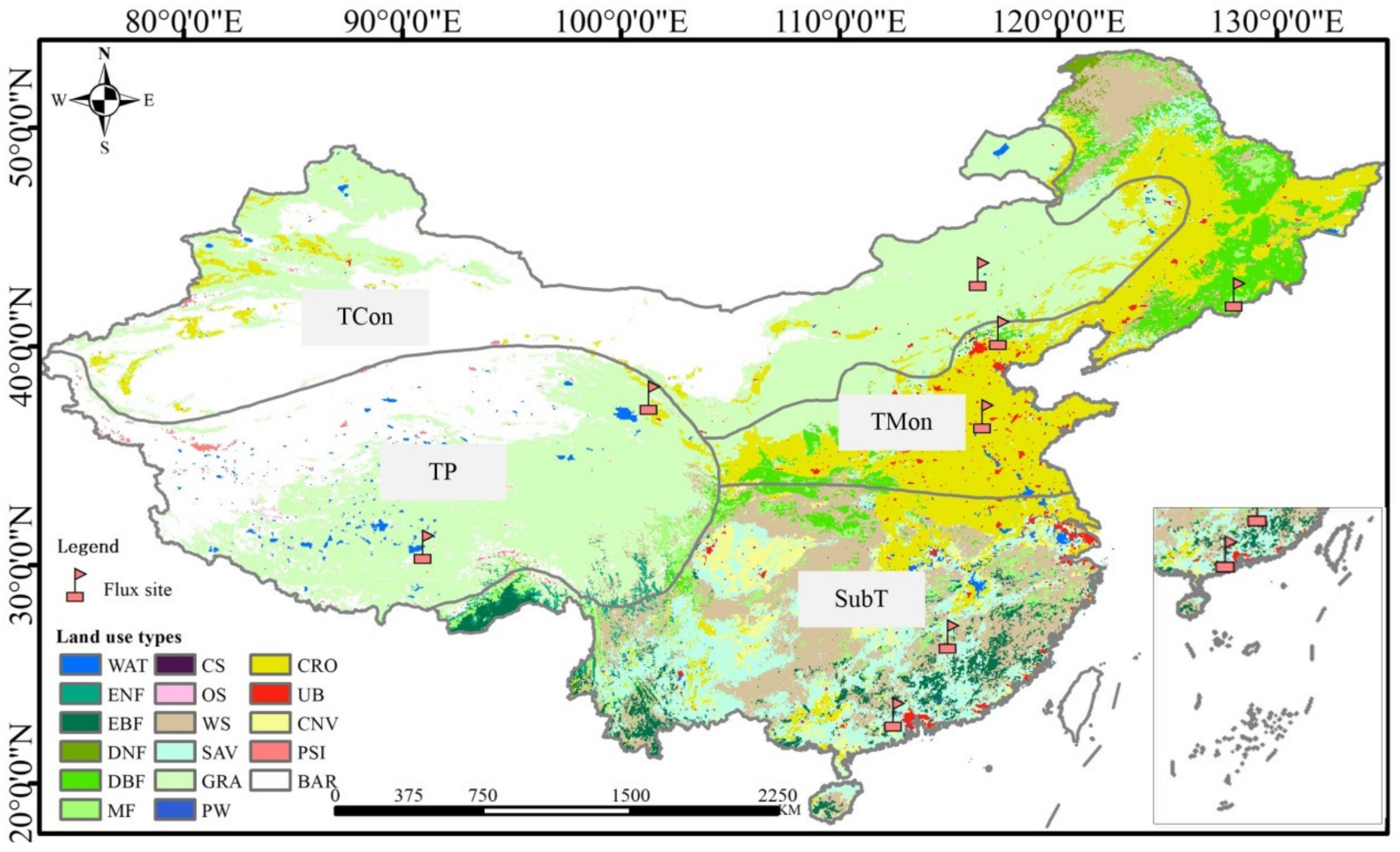
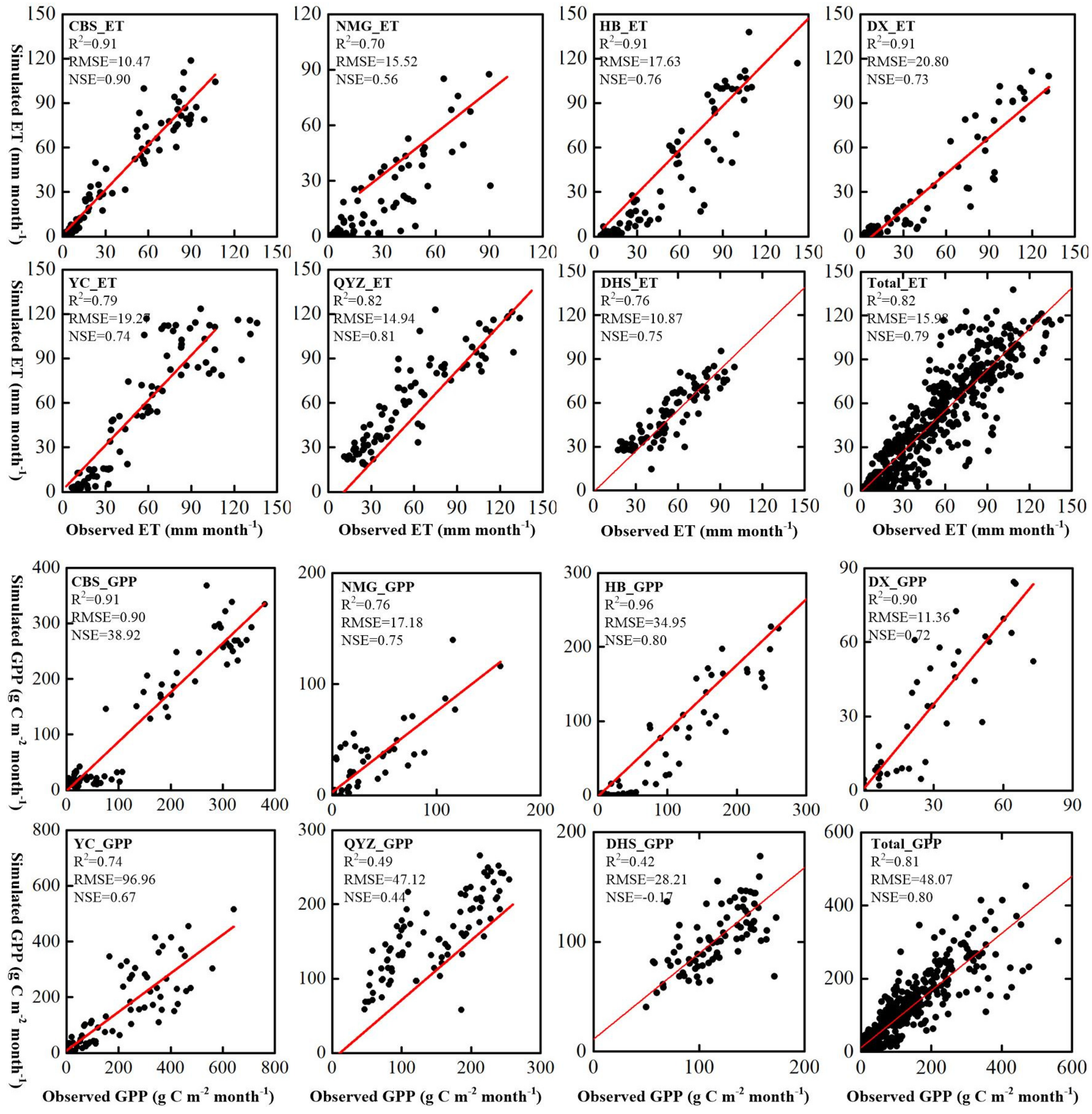
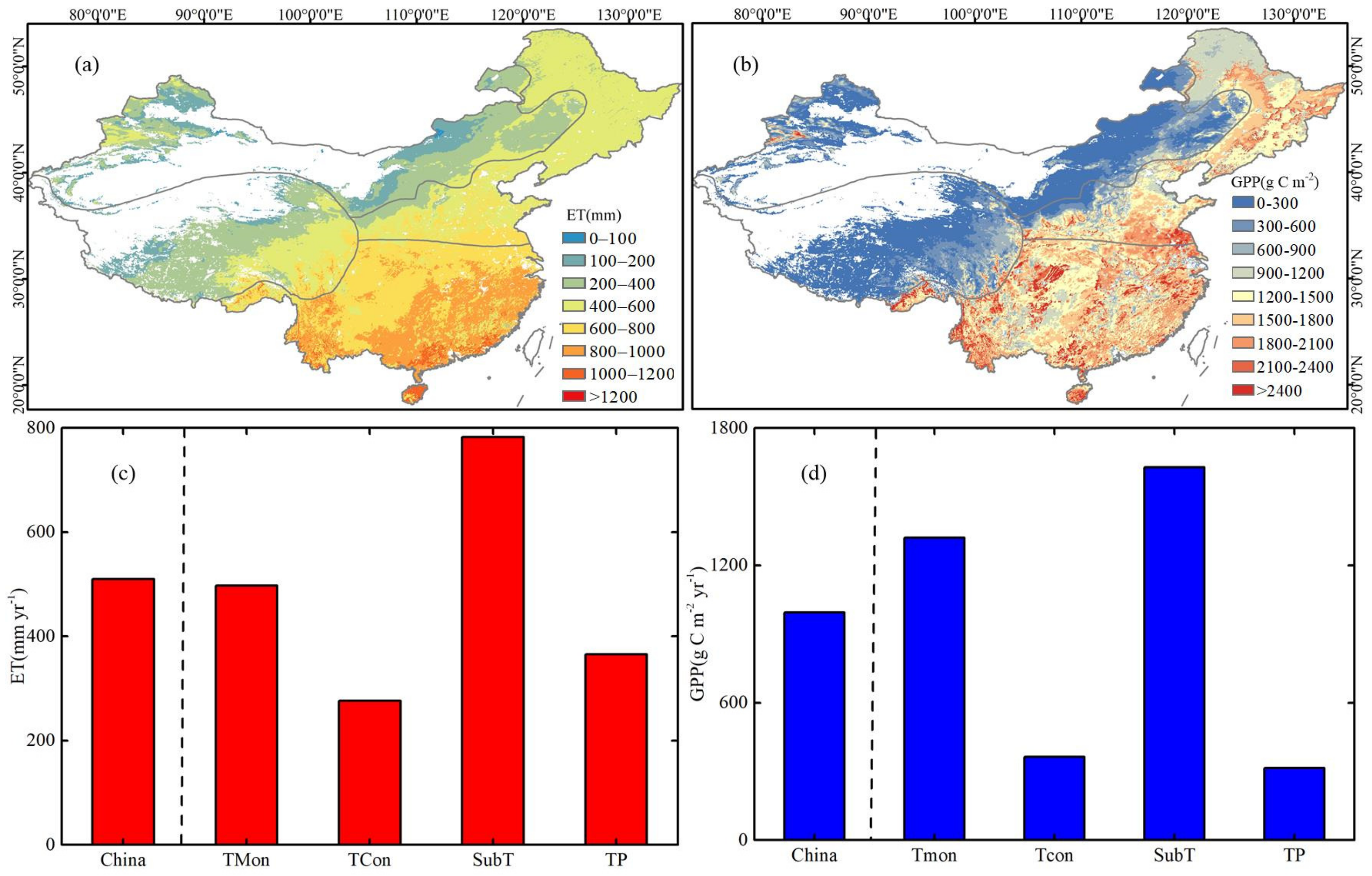
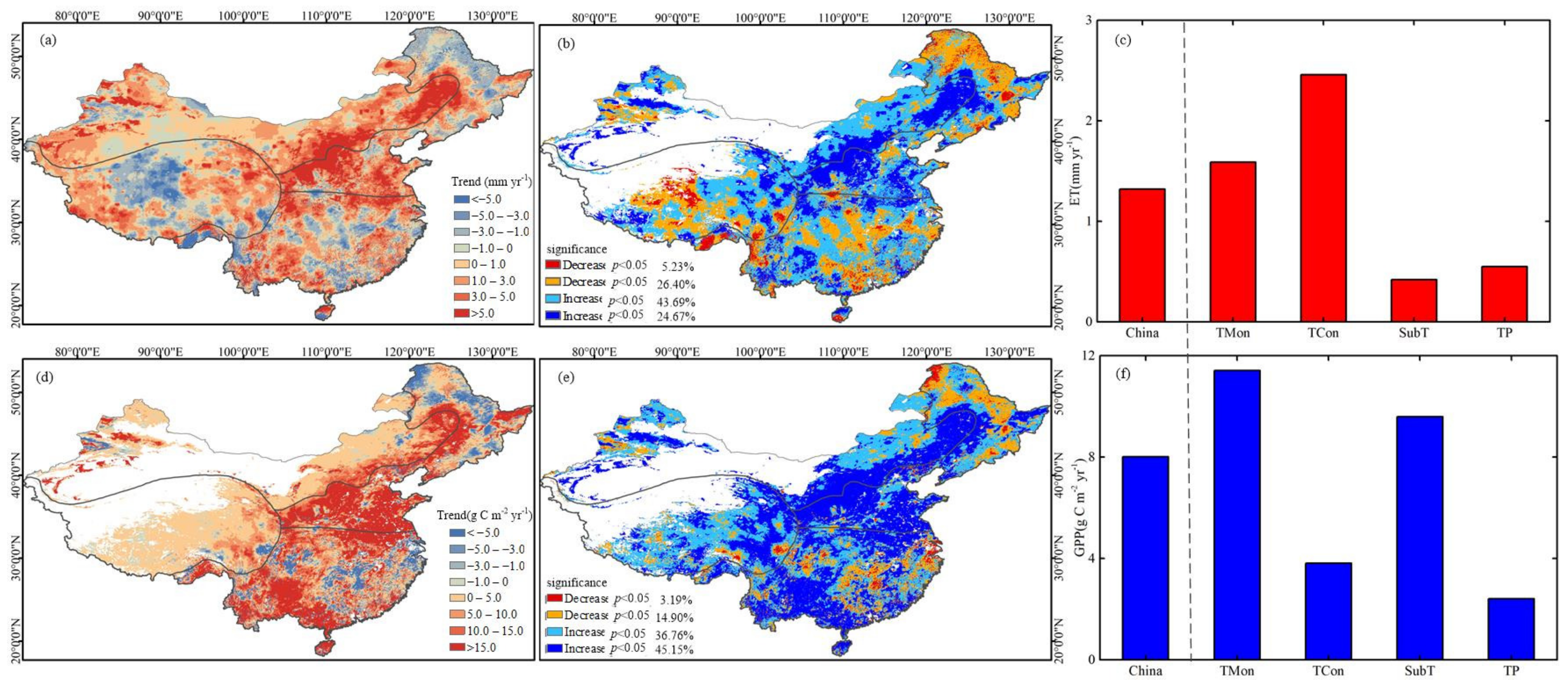
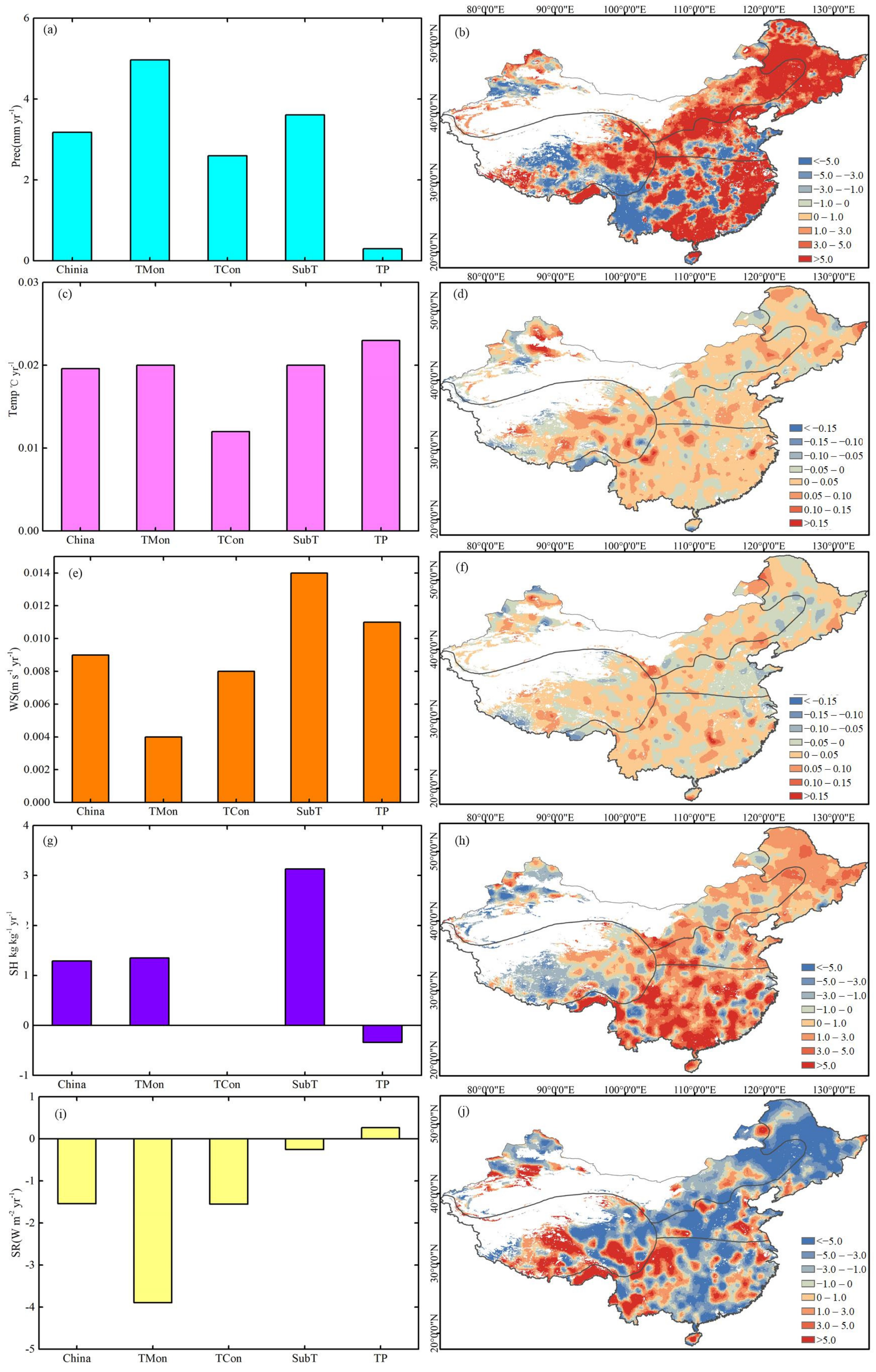
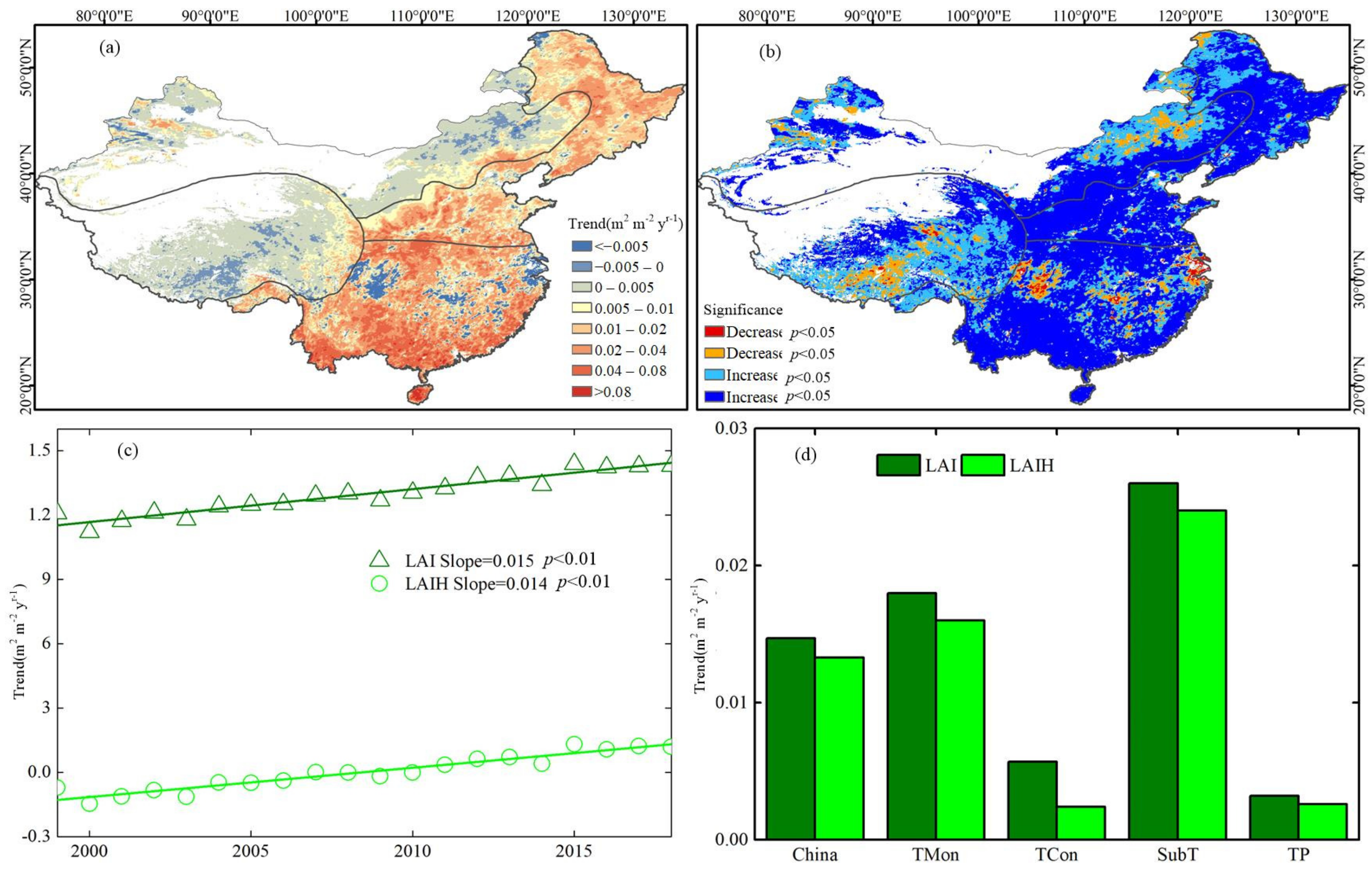
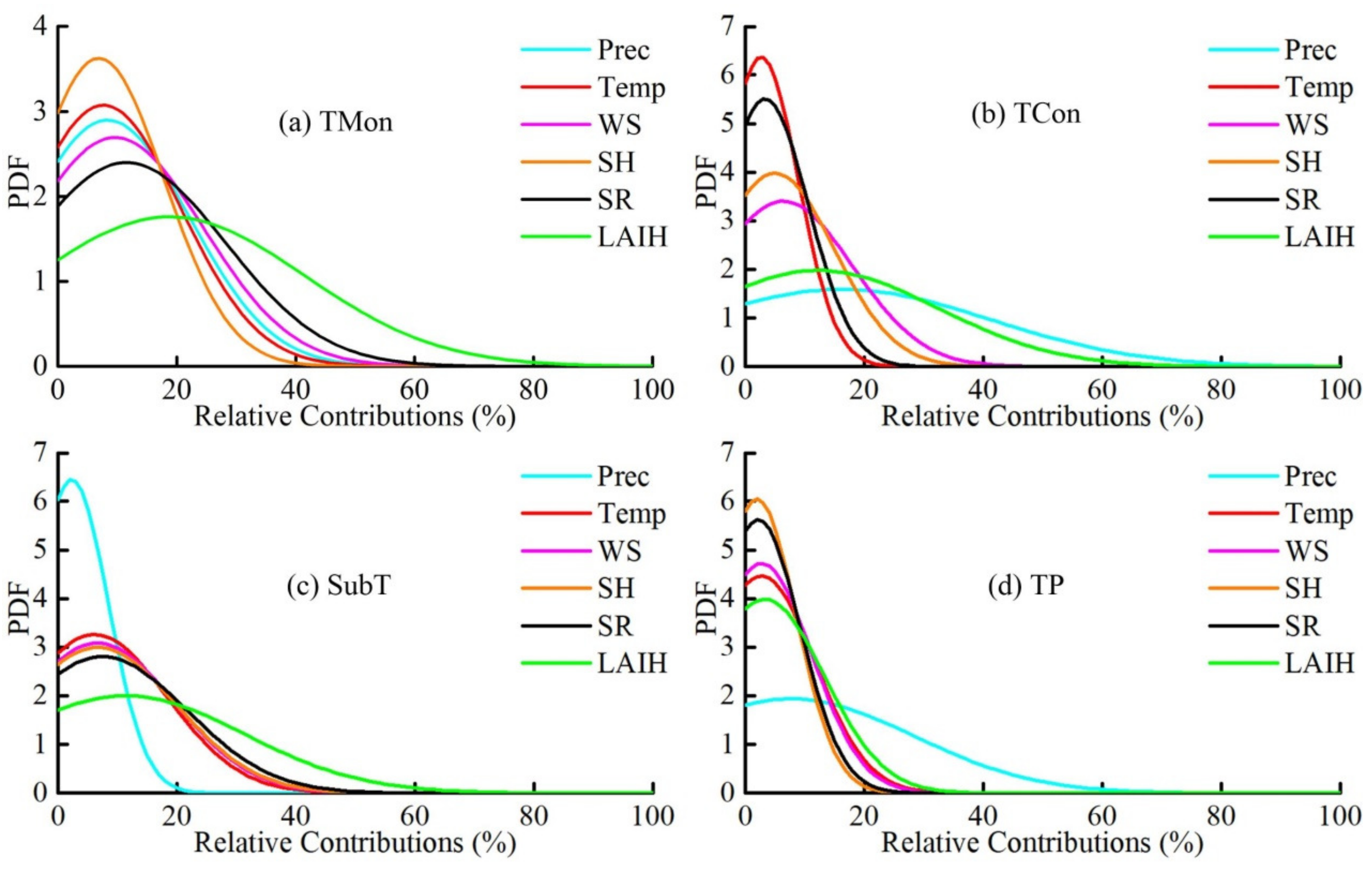
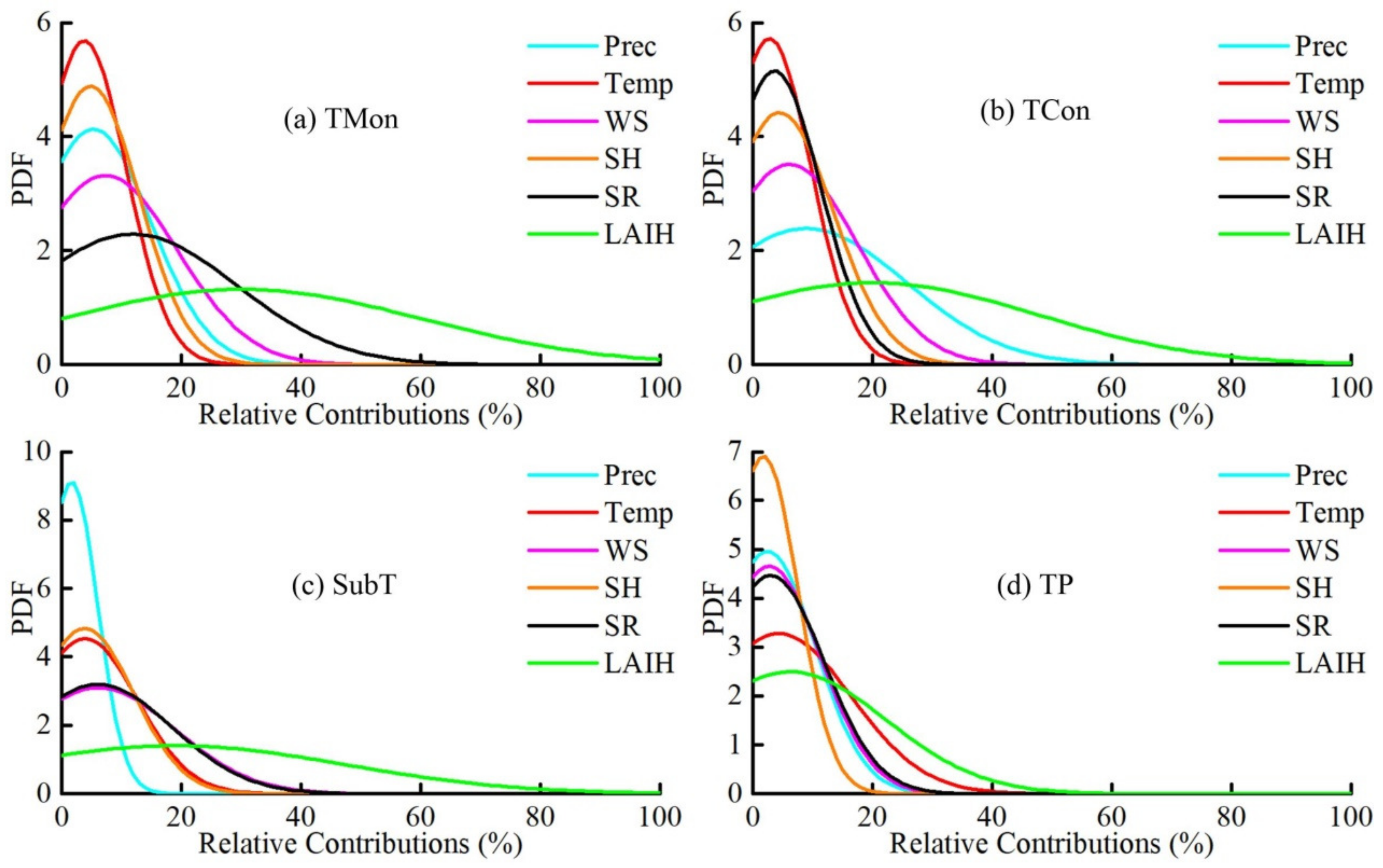
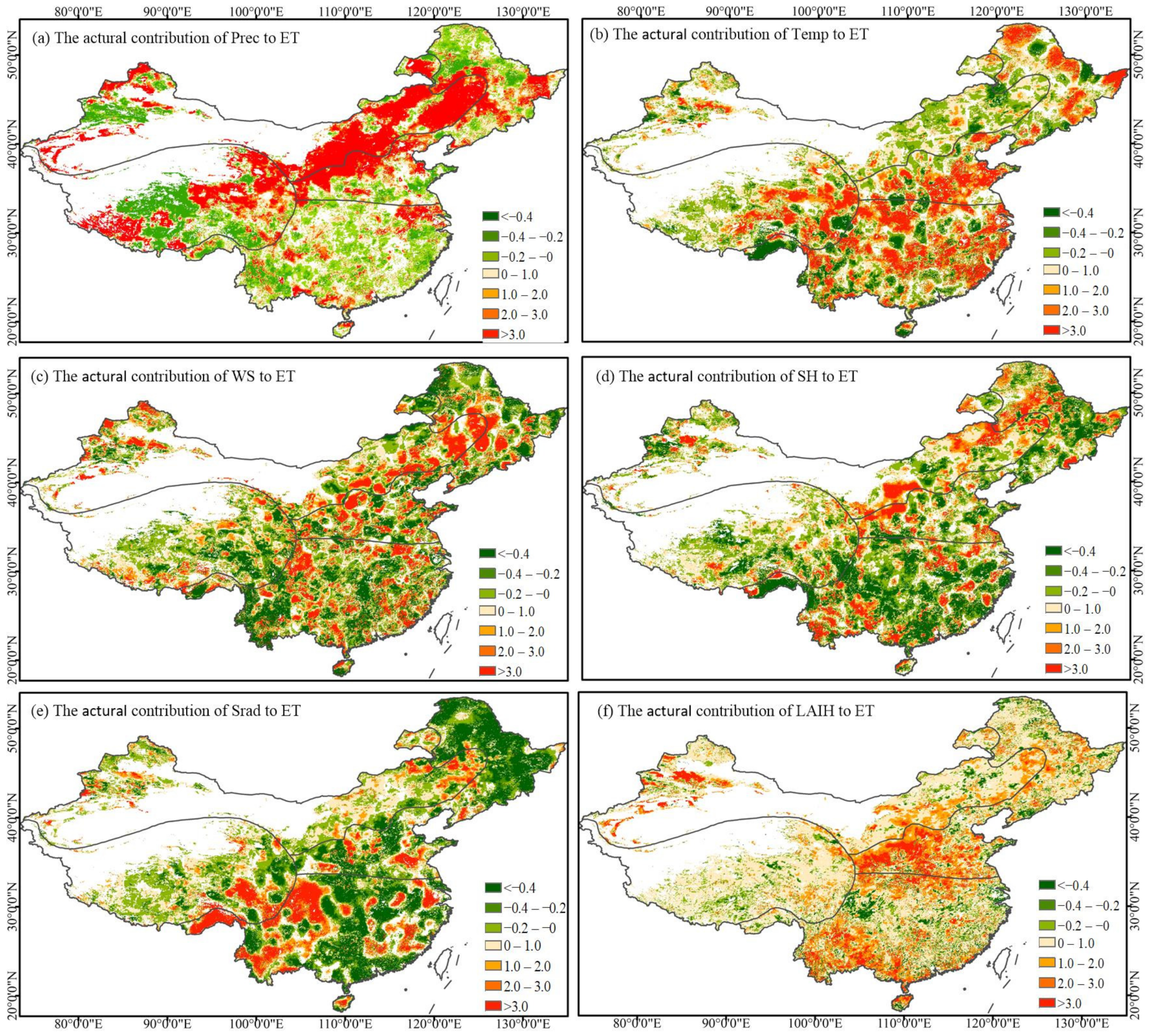
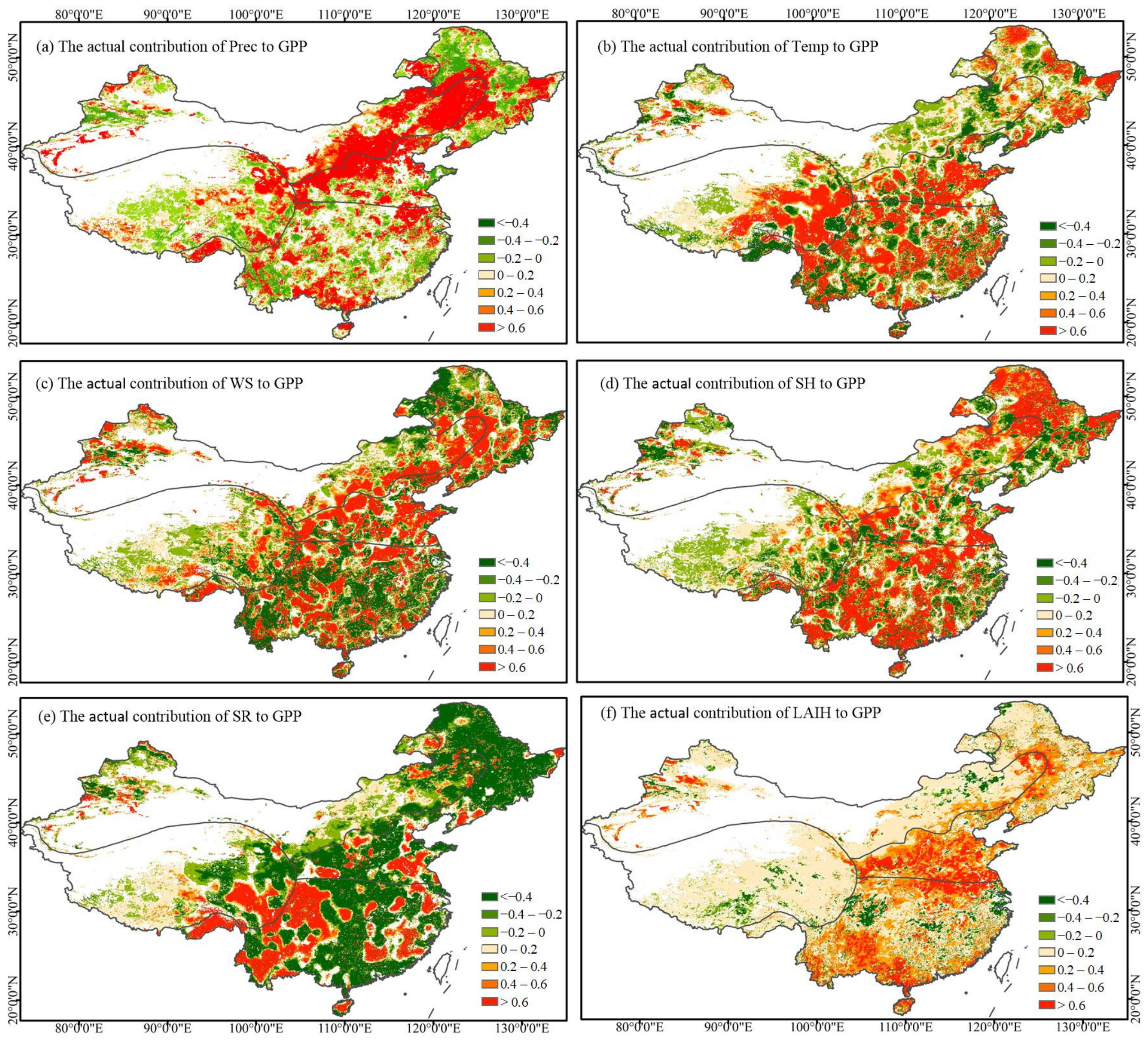

| Site | Location (°E, °N) | Land Cover Type | Range |
|---|---|---|---|
| CBS | 128.10, 42.40 | Mixed forest (MF) | 2004–2009 |
| NMG | 117.45, 43.50 | Grass (GRA) | |
| HB | 101.32, 37.60 | Shrub (SHR) | |
| DX | 91.08, 30.85 | Grass (GRA) | |
| YC | 116.60, 26.95 | Crop (CRO) | |
| QYZ | 115.07, 26.73 | Evergreen needleleaf forest (ENF) | |
| DHS | 112.56, 23.01 | Evergreen broadleaf forest (EBF) |
| Model | Parameter | ENF | EBF | DNF | DBF | MF | SHR | GRA | CRO | CNV |
|---|---|---|---|---|---|---|---|---|---|---|
| ET | gsx | 0.005 | 0.003 | 0.005 | 0.005 | 0.006 | 0.005 | 0.008 | 0.009 | 0.009 |
| LUE | ε | 1.43 | 0.75 | 1.31 | 1.30 | 1.34 | 1.18 | 1.21 | 2.69 | 2.69 |
| Prec | Temp | WS | SH | SR | LAIH | ||
|---|---|---|---|---|---|---|---|
| TMon | ET | 13.78 | 12.26 | 14.78 | 11.02 | 18.42 | 29.72 |
| GPP | 8.84 | 5.97 | 10.87 | 7.70 | 18.85 | 47.75 | |
| TCon | ET | 36.84 | 5.64 | 13.27 | 10.65 | 7.19 | 26.33 |
| GPP | 20.79 | 5.92 | 12.52 | 9.61 | 7.69 | 43.39 | |
| SubT | ET | 5.73 | 15.15 | 15.79 | 16.43 | 18.37 | 28.50 |
| GPP | 4.15 | 9.67 | 14.35 | 9.42 | 14.84 | 47.55 | |
| TP | ET | 38.59 | 13.46 | 12.73 | 9.29 | 10.16 | 15.78 |
| GPP | 12.43 | 21.53 | 12.29 | 8.47 | 14.39 | 30.90 |
| Sub-Region | Prec | Temp | WS | SH | SR | LAIH | |
|---|---|---|---|---|---|---|---|
| TMon | ET | 0.38 | 0.33 | −0.06 | −0.04 | −0.62 | 1.12 |
| GPP | 0.76 | 0.47 | 0.53 | 0.57 | −2.03 | 7.95 | |
| TCon | ET | 0.93 | 0.00 | 0.17 | 0.12 | 0.04 | 0.87 |
| GPP | 1.14 | 0.04 | 0.53 | 0.27 | −0.17 | 3.35 | |
| SubT | ET | 0.03 | 0.29 | −0.14 | −0.39 | −0.17 | 0.88 |
| GPP | 0.30 | 0.48 | 0.20 | 0.70 | −0.01 | 6.84 | |
| TP | ET | 0.02 | 0.18 | −0.14 | −0.12 | 0.03 | 0.39 |
| GPP | 0.18 | 0.46 | 0.09 | 0.00 | −0.02 | 0.95 |
Disclaimer/Publisher’s Note: The statements, opinions and data contained in all publications are solely those of the individual author(s) and contributor(s) and not of MDPI and/or the editor(s). MDPI and/or the editor(s) disclaim responsibility for any injury to people or property resulting from any ideas, methods, instructions or products referred to in the content. |
© 2024 by the authors. Licensee MDPI, Basel, Switzerland. This article is an open access article distributed under the terms and conditions of the Creative Commons Attribution (CC BY) license (https://creativecommons.org/licenses/by/4.0/).
Share and Cite
Huang, Y.; Yang, S.; Zhao, H. Distinct Contributions of Climate Change and Anthropogenic Activities to Evapotranspiration and Gross Primary Production Variations over Mainland China. Remote Sens. 2024, 16, 475. https://doi.org/10.3390/rs16030475
Huang Y, Yang S, Zhao H. Distinct Contributions of Climate Change and Anthropogenic Activities to Evapotranspiration and Gross Primary Production Variations over Mainland China. Remote Sensing. 2024; 16(3):475. https://doi.org/10.3390/rs16030475
Chicago/Turabian StyleHuang, Yingchun, Shengtian Yang, and Haigen Zhao. 2024. "Distinct Contributions of Climate Change and Anthropogenic Activities to Evapotranspiration and Gross Primary Production Variations over Mainland China" Remote Sensing 16, no. 3: 475. https://doi.org/10.3390/rs16030475
APA StyleHuang, Y., Yang, S., & Zhao, H. (2024). Distinct Contributions of Climate Change and Anthropogenic Activities to Evapotranspiration and Gross Primary Production Variations over Mainland China. Remote Sensing, 16(3), 475. https://doi.org/10.3390/rs16030475




